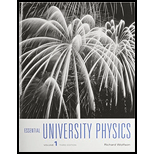
Concept explainers
You’re preparing an exhibit for the Golf Hall of Fame, and you realize that the longest golf shot in history was Astronaut Alan Shepard’s lunar drive. Shepard, swinging single-handed with a golf club attached to a lunar sample scoop, claimed his ball went “miles and miles.” The record for a single-handed golf shot on Earth is 257 m. Could Shepard’s ball really have gone “miles and miles”? Assume the ball’s initial speed is independent of gravitational acceleration.
Want to see the full answer?
Check out a sample textbook solution
Chapter 8 Solutions
Essential University Physics, Volume 1 and Volume 2 - With Access
Additional Science Textbook Solutions
Physics (5th Edition)
Conceptual Integrated Science
The Cosmic Perspective Fundamentals (2nd Edition)
Essential University Physics: Volume 2 (3rd Edition)
Physics for Scientists and Engineers: A Strategic Approach with Modern Physics (4th Edition)
College Physics
- The dwarf planet Pluto has a radius of 1.15 x 10^6 m and a mass of 1.2x10^22 kg . What is the value of g on the surface of Pluto?arrow_forwardEuropa, a satellite of Jupiter, is believed to have a liquid ocean of water (with a possibility of life) beneath its icy surface. In planning a future mission to Europa, what is the fastest that an astronaut with legs of length 0.70 m could walk on the surface of Europa? Europa is 3100 km in diameter and has a mass of 4.8 x 10^22 kg.arrow_forwardIn 2014, the Rosetta space probe reached the comet Churyumov– Gerasimenko. Although the comet’s core is actually far from spherical, in this problem we’ll model it as a sphere with a mass of 1.0 x 1013 kg and a radius of 1.6 km. If a rock were dropped from a height of 1.0 m above the comet’s surface, how long would it take to hit the surface?arrow_forward
- The value of acceleration due to gravity (g) at a distance of 2R from the surface of earth, where R is the radius of earth is ______. A) g/3 B) g/4 C) g/9 D) g/2arrow_forwardA newly discovered planet has a radius of 4.7×106 m and a mass of 5.5×1024 kg . If a rock on this planet were to fall from a height of 1.0 m, what would its speed be when it hit the ground? Assume that air resistance is very small on this planet. 5.8 m/s 4.4 m/s 3.8 m/s 18 m/sarrow_forwardSuppose an astronaut landed on a planet where g = 19.6 m>s2. Compared to earth, would it be easier, harder, or just as easy for her to walk around? Would it be easier, harder, or just as easy for her to catch a ball that is moving horizontally at 12 m>s? (Assume that the astronaut’s spacesuit is a lightweight model that doesn’t impede her movements in any way.)arrow_forward
- A satellite of mass 5500 kg orbits the Earth and has a period of 1.75 h. The mass of theEarth is 5.97×1024 kg, the radius of the Earth is 6.37×106 m, and G = 6.67× 10−11 N ∙ m2/kg2.(a) Determine the radius of its circular orbit.(b) Find the magnitude of the Earth’s gravitational force on the satellite.(c) Find the total energy of the satellite in its orbit.arrow_forwardIt is found that when a particular object with a mass of 0.41 kg is released from rest while immersed within a certain substance, the coefficient of proportionality regarding the resistive force is 0.621 kg/s. What is the magnitude of the resistive force that acts on this mass 1.49 s after being released? Let the resistive force be given by R = -bv (Assume that the gravitational force also acts)arrow_forwardWhat is the escape speed from a planet of mass M = 3.1 x 1023 kg and radius R = 2.6 x 106 m? Write the answer in terms of km/s.arrow_forward
- An exoplanet (JB-2285), located in the galaxy closest to ours, uses a system where the units of mass and force are phljmth and xwyflr. respectively. Xwyflr is defined as the unit of force required to accelerate a unit mass, phljmth, with the gravitational acceleration (in m/s2) on the surface of the exoplanet which is seven tenths of the gravitational acceleration on earth’s surface (9.8066 m/s2). a. What is the conversion factor to convert a force in xwyflr to force in phljmth●m/s2? b. Calculate the weight in xwyflr of a 14.28 phljmth object on the surface of the exoplanet JB-2285. c. Determine the weight of the object in (b) in Newtons (N) in Mintal, Davao City if 137.224 N = 1.00 xwyflr? d. What is the mass in grams of a 796.2-phljmth object?arrow_forwardObserving a spacecraft land on a distant asteroid, scientists notice that the craft is falling at a rate of 5 m/s. When it is 100 m closer to the surface of the asteroid, the craft reports a velocity of 8 m/s. According to their data, what is the approximate gravitational acceleration on this asteroid?arrow_forwardBy what factor will the acceleration due to gravity change if the mass of a planet is double and the size of the planet is also doubled?arrow_forward
 Principles of Physics: A Calculus-Based TextPhysicsISBN:9781133104261Author:Raymond A. Serway, John W. JewettPublisher:Cengage Learning
Principles of Physics: A Calculus-Based TextPhysicsISBN:9781133104261Author:Raymond A. Serway, John W. JewettPublisher:Cengage Learning Classical Dynamics of Particles and SystemsPhysicsISBN:9780534408961Author:Stephen T. Thornton, Jerry B. MarionPublisher:Cengage Learning
Classical Dynamics of Particles and SystemsPhysicsISBN:9780534408961Author:Stephen T. Thornton, Jerry B. MarionPublisher:Cengage Learning

